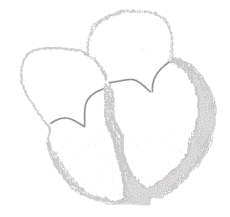Supraventricular Tachycardia
Supraventricular tachycardia (SVT) is an umbrella term for abnormally fast heart rhythms originating from the upper part of the heart, specifically the atria or the atrioventricular (AV) node. This condition contrasts with ventricular tachycardia, which arises from the lower chambers of the heart. SVT encompasses several specific arrhythmias, including atrial fibrillation, atrial flutter, paroxysmal supraventricular tachycardia (PSVT), and Wolff-Parkinson-White syndrome.
Signs and Symptoms
SVT symptoms can appear suddenly and may resolve without intervention. They can be triggered by stress, exercise, or emotional factors, and episodes can last from a few minutes to several days. Common symptoms include palpitations, feeling faint, sweating, shortness of breath, chest pain, rapid breathing, dizziness, and, in severe cases, loss of consciousness. In infants and toddlers, symptoms may manifest as a lack of interest in feeding, shallow breathing, lethargy, vomiting, and decreased responsiveness.

Pathophysiology
SVT mechanisms include re-entry circuits and increased automaticity of cardiac muscle cells. The AV node acts as a gating mechanism, limiting the number of impulses that pass to the ventricles. However, accessory pathways, such as in Wolff-Parkinson-White syndrome, can bypass this protection, leading to faster ventricular rates.

Diagnosis
Diagnosis of SVT typically involves an electrocardiogram (ECG), Holter monitor, or event monitor. Subtypes of SVT can be distinguished by their ECG characteristics, with most presenting narrow QRS complexes. In cases of electrical conduction abnormalities, a wide QRS complex may mimic ventricular tachycardia. Algorithms exist to differentiate between supraventricular and ventricular tachycardia, very important as they require different treatments.


Classification
SVT can be classified by their specific site of origin. Subtypes include sinoatrial nodal reentrant tachycardia (SNRT), ectopic (unifocal) atrial tachycardia (EAT), multifocal atrial tachycardia (MAT), and atrioventricular reentrant tachycardia (AVRT), among others. Each subtype has distinct ECG features and mechanisms.
Treatment
Treatment of SVT depends on the subtype and severity. Initial management may include vagal manoeuvres, which stimulate the vagus nerve to slow heart rate, and medications such as adenosine, beta-blockers, or calcium channel blockers for rate control. For recurrent or persistent SVT, catheter ablation may be considered. Radiofrequency ablation uses a catheter to destroy abnormal electrical pathways, offering a high success rate for certain SVT types. Cryoablation, an alternative to radiofrequency ablation, uses extreme cold to ablate tissue with a lower risk of damaging the AV node.
Prevention
Preventive measures may involve lifestyle changes, medications, or medical procedures. For those with infrequent or minimally symptomatic episodes, observation may suffice. More frequent or disabling symptoms may require beta-blockers, antiarrhythmic drugs, or catheter ablation.

Notable Cases
Several public figures have been diagnosed with SVT, including Tony Blair, Miley Cyrus, and various athletes. Their experiences highlight the condition's impact on diverse populations.
Note: This summary is intended to inform UK dentists preparing for professional exams about SVT in general medicine and surgery.
Self-assessment MCQs (single best answer)
Which of the following conditions is not considered a type of supraventricular tachycardia (SVT)?
What is the primary difference between supraventricular tachycardia (SVT) and ventricular tachycardia?
Which symptom is not commonly associated with SVT?
Which diagnostic tool is most commonly used to identify SVT?
In Wolff-Parkinson-White syndrome, what is the main mechanism causing SVT?
What is the typical appearance of SVT on an ECG?
Which of the following is a first-line intervention for acute management of SVT?
Which of the following treatment options involves using extreme cold to destroy abnormal electrical pathways?
Which lifestyle factor is least likely to trigger an episode of SVT?
Which subtype of SVT is characterised by multiple atrial foci causing irregular atrial rhythms?
Dentaljuce
Dentaljuce provides Enhanced Continuing Professional Development (CPD) with GDC-approved Certificates for dental professionals worldwide.
Founded in 2009 by the award-winning Masters team from the School of Dentistry at the University of Birmingham, Dentaljuce has established itself as the leading platform for online CPD.
With over 100 high-quality online courses available for a single annual membership fee, Dentaljuce offers comprehensive e-learning designed for busy dental professionals.
The courses cover a complete range of topics, from clinical skills to patient communication, and are suitable for dentists, nurses, hygienists, therapists, students, and practice managers.
Dentaljuce features Dr. Aiden, a dentally trained AI-powered personal tutor available 24/7 to assist with queries and provide guidance through complex topics, enhancing the learning experience.
Check out our range of courses, or sign up now!


